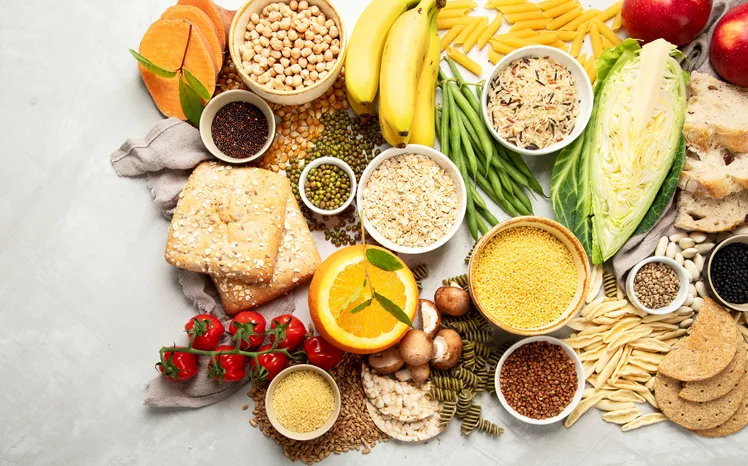How to Eat for Blood Sugar Balance

We explore the key to maintaining optimal blood sugar balance through a healthy diet, and the importance of glucose structure. Learn about foods that promote this balance, plus indulge in three delicious recipes for a healthier lifestyle and balanced blood sugar levels. Read on to learn more about it all!
Your body is like a well-oiled machine, fueled by a magical energy source called blood sugar. Optimal glucose levels (the scientific term for blood sugar) is an essential factor that can make or break your overall health. When you eat delicious foods containing carbohydrates (and sometimes protein), these nutrients embark on a remarkable journey through your digestive system and are broken down into various molecules, including glucose. Once released into your bloodstream, glucose is ready to perform its heroic tasks, but it can’t do it alone. That’s where your trusty pancreas steps in, producing a hormone called insulin. Picture insulin as the master key, unlocking the doors of your body’s cells, allowing glucose to enter and work its magic.
Our pancreas produces the hormone insulin when it senses elevated blood glucose levels. Normal, healthy insulin sensitivity means that our cells are able to readily take in glucose in response to insulin. This enables our bodies to maintain stable glucose levels and in turn a steady source of energy for our bodily functions and activities- everything from walking to running. However, if someone develops insulin resistance, their cells are less responsive (also referred to as being less sensitive) to the signals from insulin. This results in higher levels of insulin required to do the job, which in turn can lead to prolonged elevated blood glucose levels and even prediabetes or type 2 diabetes.
There are various factors that can contribute to insulin resistance such as:
- Genetics
- Some individuals may be genetically predisposed to have less sensitivity to insulin. This can lead to less metabolism of glucose in the body.
- Medical conditions
- Conditions like polycystic ovary syndrome (PCOS) and hormonal disorders can affect insulin sensitivity and require medical care to manage.
- Body weight and composition
- Excess body weight and excess fat around the abdomen (visceral fat) can increase risk of insulin resistance.
- Physical activity
- Regular exercise and physical activity help improve insulin sensitivity. Activities like strength training and even walking help the body utilize glucose more effectively and improve insulin sensitivity.
- Sleep and stress
- Poor sleep and high stress can disrupt hormone regulation and negatively impact insulin sensitivity.
- Diet and nutrient intake
- The types and amounts of macronutrients- carbohydrates, fats and proteins- consumed in the diet can influence insulin sensitivity. Opting for a well-balanced diet that incorporates whole grains, fruits, vegetables, lean proteins, and healthy fats can support normal glucose regulation. It is equally important to limit the consumption of sugary foods, as prolonged exposure to excessive glucose from sugars can contribute to insulin resistance.

When it comes to carbohydrates, their quality becomes a pivotal factor, considering their varying digestibility, absorption rates, and metabolic impacts. Good quality carbs derived from whole foods like fruits, vegetables, and dairy products are highly recommended. On the other hand, simple carbohydrates from refined sugars pose a higher risk to health. Evaluating the glycemic index of foods helps gauge their impact on post-meal glucose levels. Foods with a lower glycemic index (below 55) are digested, absorbed, and metabolized more slowly, resulting in slower and/or lower increases in blood glucose. Other dietary factors, such as nutrient composition, calorie density, acid levels, processing and cooking methods, and food forms, also influence postprandial glucose levels. Glycemic index of foods can be searched here.
Traditionally, concern about glucose levels was most a concern of individuals with diabetes or prediabetes. However, the advent of continuous glucose monitors (CGMs) has made monitoring glucose levels more accessible, even for those without diabetes. These cutting-edge devices, attached to the skin with tiny filaments, monitor glucose levels in the interstitial fluid, providing insights into the effects of food choices, mood, sleep, and other factors on glucose dynamics.
Postprandial glucose level refers to the amount of glucose in the blood after a meal, specifically within the timeframe following the meal. By monitoring postprandial glucose levels, we can gain insights into how our body processes and utilizes glucose from the food we consume. Researchers have evaluated different ways that we can influence our post prandial glucose levels and measures of overall amount and duration of glucose in our bloodstream.
The Breakdown
Time of Day
Research from the National Health and Nutrition Examination Survey (NHANES), a large national survey, investigated whether the timing of meals affects metabolism. The study revealed that starting to eat earlier in the day was associated with lower fasting glucose levels. Additionally, each hour of delay in eating was linked to higher glucose levels.
Energy Consumption and Timing:
A clinical study found that consuming more calories earlier in the day was associated with improved insulin sensitivity and better ability to metabolize glucose.
Eating Fat or Protein with Carbohydrates
In a controlled study, participants were given meals with equivalent calories, either following a standard diet (55% carbohydrates, 27% fat) or a reduced carbohydrate (43%) and higher fat (39%) diet. The study showed that the total glucose area under the curve, which represents the duration and increase in glucose levels, improved with the high fat, low carb diet.
Adding Fiber to Carbohydrate Meals
Fiber slows down the digestion and absorption of food, including glucose. A clinical study involving individuals with normal glucose metabolism explored the effects of adding fiber to the diet. The participants consumed meals consisting of either regular white bread or white bread enriched with fiber. After 72 hours, the group that consumed the high fiber meals demonstrated better clearance of glucose from the blood, indicating improved glucose metabolism and insulin utilization
Order of Consuming Foods
In a study of individuals with type 2 diabetes, consuming test meals in a laboratory setting where carbohydrates were eaten last (either after vegetables or proteins), postprandial glucose levels were lower, as were insulin levels.
Three Recipes for Blood Sugar Balance
Recipe 1: Nutritious Breakfast Bowl
A delicious and satisfying breakfast recipe packed with fiber, protein, and healthy fats to stabilize blood sugar.
Ingredients:
- ½ cup rolled oats
- ½ cup plain Greek yogurt
- 1 tablespoon chia seeds
- ¼ cup mixed berries
- 1 tablespoon unsweetened shredded coconut
- 1 tablespoon chopped nuts
- 1 teaspoon honey or maple syrup
- A sprinkle of cinnamon
Instructions:
In a bowl, combine the rolled oats, Greek yogurt, and chia seeds.
Mix well until the ingredients are evenly combined.
Let the mixture sit for a few minutes to allow the oats and chia seeds to absorb some liquid.
Top the oat and yogurt mixture with the mixed berries, shredded coconut, and chopped nuts.
Drizzle with honey or maple syrup if desired for added sweetness.
Sprinkle a little cinnamon on top for extra flavor.
Total approximate nutritional values:
- Calories: 355-475 calories
- Carbohydrates: 50-61 grams
- Fiber: 13-16 grams
- Fat: 14-20 grams
- Protein: 20.5-24.5 grams
Recipe 2: Flavorful Veggie Stir-Fry
A quick and easy stir-fry recipe featuring a variety of colorful vegetables known for their low glycemic index.
Ingredients:
- 1/2 tablespoon olive oil
- 1/4 medium onion, sliced
- 2 cloves garlic, minced
- 1 small zucchini, sliced
- 1/2 cup broccoli florets
- 1/2 cup snap peas
- 1/2 cup mushrooms, sliced
- 6 ounces firm tofu, drained and cubed
- 2 tablespoons low-sodium soy sauce
- 1 tablespoon sesame oil
- 1 tablespoon rice vinegar
- 1 teaspoon honey or maple syrup (optional, for a touch of sweetness)
- 1/4 teaspoon red pepper flakes (optional, for some heat)
- Salt and pepper to taste
- Fresh cilantro or green onions for garnish (optional)
- 1 cup cooked brown rice
Instructions:
Heat the olive oil in a large skillet or wok over medium heat.
Add the sliced onion and minced garlic to the pan and sauté for 2-3 minutes until they start to soften.
Add the zucchini, broccoli, snap peas, and mushrooms to the pan. Stir-fry for 5-7 minutes until the vegetables are crisp-tender.
Push the vegetables to one side of the pan and add the tofu cubes to the other side. Cook the tofu for 3-4 minutes, allowing it to brown slightly.
In a small bowl, whisk together the soy sauce, sesame oil, rice vinegar, honey or maple syrup (if using), red pepper flakes (if using), salt, and pepper.
Pour the sauce over the vegetables and tofu in the pan and toss to coat evenly. Continue to cook for another 1-2 minutes until the sauce is heated through and the flavors are well combined.
Taste and adjust the seasonings if needed.
Total approximate nutritional values:
- Calories: 400-500 calories
- Carbohydrates: 50-60 grams
- Fiber: 8-10 grams
- Fat: 16-20 grams
- Protein: 20-25 grams
Recipe 3: Protein-Packed Quinoa Salad
A wholesome salad recipe combining quinoa, leafy greens, and lean protein sources to promote stable blood sugar levels.
Ingredients:
- 1/2 cup cooked quinoa
- 2 cups mixed salad greens (such as spinach, kale, or arugula)
- 3 ounces grilled chicken breast, sliced
- 1/4 cup cooked chickpeas
- 1/4 cup diced cucumber
- 1/4 cup cherry tomatoes, halved
- 1/4 cup diced bell peppers
- 2 tablespoons crumbled feta cheese (optional)
- 1 tablespoon chopped fresh herbs (such as basil, parsley, or cilantro)
- Juice of 1/2 lemon
- 1 tablespoon extra-virgin olive oil
- Salt and pepper to taste
Instructions:
In a large bowl, combine the cooked quinoa, mixed salad greens, grilled chicken breast, chickpeas, cucumber, cherry tomatoes, bell peppers, and crumbled feta cheese (if using).
In a small bowl, whisk together the lemon juice, extra-virgin olive oil, salt, and pepper to make the dressing.
Drizzle the dressing over the salad and toss well to coat all the ingredients.
Sprinkle the chopped fresh herbs over the salad for added flavor.
Taste and adjust the seasoning if needed.
Total approximate nutritional values:
- Calories: 350-400 calories
- Carbohydrates: 25-30 grams
- Fiber: 4-6 grams
- Fat: 15-18 grams
- Protein: 25-30 grams
conclusion
Research has provided valuable insights into the impact of dietary choices on postprandial glucose levels. Including fat or protein with carbohydrates, incorporating fiber to slow glucose absorption, consuming vegetables and proteins first during meals, and considering the timing of eating throughout the day all play a significant role in promoting optimal glucose metabolism and insulin sensitivity. These findings emphasize the importance of making informed dietary decisions to maximize our body’s potential. Additionally, it is crucial to manage glucose levels as hyperglycemia can lead to oxidative stress, inflammation, increased fat storage, and weight gain. By incorporating fiber, opting for complex carbohydrates, balancing macronutrients, and considering meal order, we can support healthy glucose metabolism and overall well-being.
Source link
#Eat #Blood #Sugar #Balance



